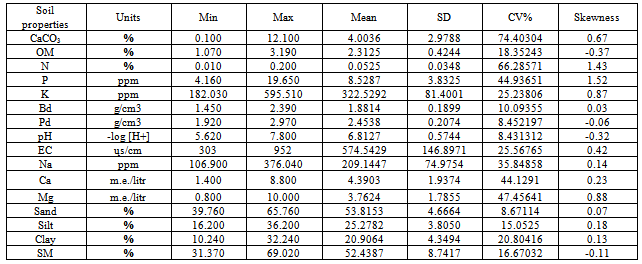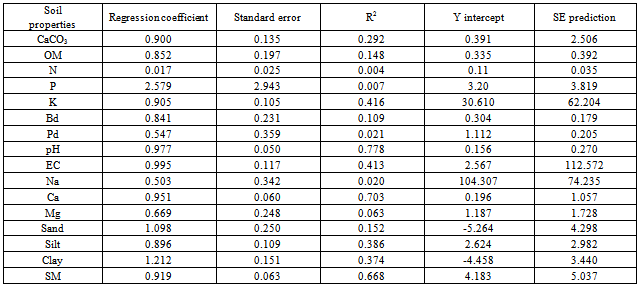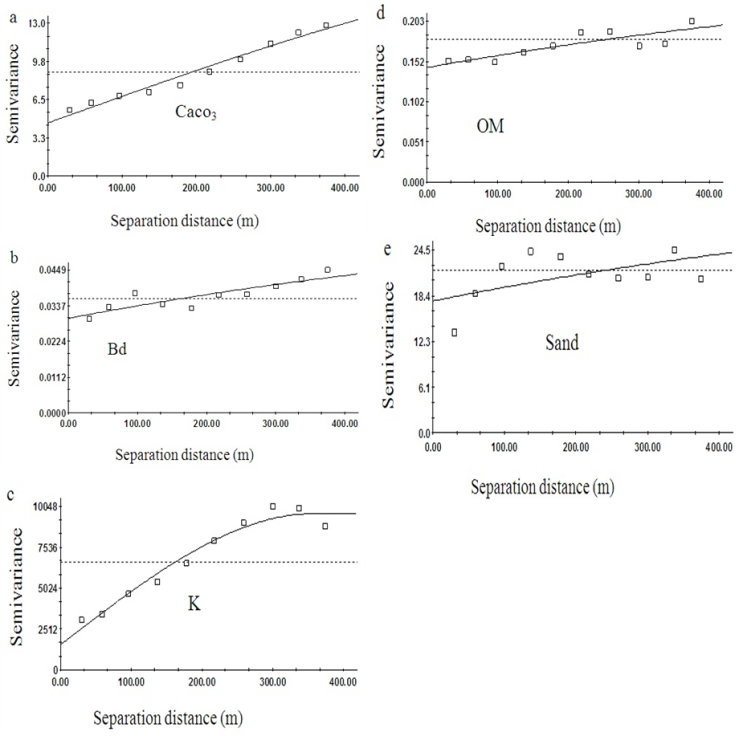| [1] | Adriana, L. D., 2007, On the use of soil hydraulic conductivity functions in the field, Soil Science, 93, 162-170 |
| [2] | Afshar, H., Salehi, M. H., Mohammadi, J., and Mehnatkesh, A., 2009, Spatial variability of soil properties and irrigated wheat yield in quantitative suitability map, a case study: Share e Kian Area, ChaharmahalevaBakhtiari province, Journal of water and soil, 23 (1), 161-172 |
| [3] | Anderson, C.J., Mitsch, W.J. and Nairn, R.W., 2005, Temporal and spatial development of surface soil conditions at two created riverine marshes, J. Environ. Qual, 34,2072-2081 |
| [4] | Ayoubi S., and Khormali, F., 2009, Spatial Variability of Soil Surface Nutrients Using Principal Component Analysis and Geostatistics: A Case Study of Appaipally Village, Andhra Pradesh, India JWSS, Isfahan University of Technology, 12 (46), 609-622 |
| [5] | Bremner, J. M., and Mulvaney, C. S., 1982. Nitrogen total. P. 595-624. In A. L. Page (ed.), Methods of soil analysis. Agron. No. 9, Part 2: Chemical and microbiological properties, 2nd ed., Am. Soc. Agron., Madison, WI, USA |
| [6] | Burke, A., 2001, Classification and ordination of plant communities of the Nauklaft mountain, Namibia, Journal of Vegetation Science, 12, 53-60 |
| [7] | Cambardella, C.A., Moorman, T. B., Parkin, T. B., Karlen, D.L. Turco. R .F. and Konopka. A. E., 1994, Field scale variability of soil properties in Central Iowa soils, Soil Sci. Soc. Am. J., 58, 1501-1511 |
| [8] | Chaneton, E.J., and Avado, R.S.L., 1996, Soil nutrients and salinity after long-term grazing exclusion in flooding pama grassland, J. Range management, 49, 182-187 |
| [9] | Cheng, X., An, S., Chen, J., Li, B., Liu, Y., and Liu, S., 2007, Spatial relationships among species, above-ground biomass, N, and P in degraded grasslands in Ordos Plateau, northwestern China, Journal of Arid Environments, 68, 652–667 |
| [10] | Covelo, F., Rodríguez, A., and Gallardo, A., 2008, Spatial pattern and scale of leaf N and P resorption efficiency and proficiencyin a Quercusrobur population, Plant Soil, 311,109–119 |
| [11] | Davatgar, N., 1998. Investigation spatial variability of some soil characteristics. Ms.c Thesis, Faculty of agriculture, Tabriz University, 108 pp |
| [12] | Davatgar, N., Neyshabouri, M. R., and Moghaddam, M.R., 2001, The Analysis of information obtained from soil variables map by use of semivariogram models. Iranian Journal of agricultural sciences, 31(4), 725-735 |
| [13] | Du Feng, L.Z., XuXuexuan, Z.X., and Shan L., 2008, Spatial heterogeneity of soil nutrients and aboveground biomass in abandoned old-fields of Loess Hilly region in Northern Shaanxi, China. ActaEcologicaSinica, 28(1), 13−22 |
| [14] | Emadi, M., Baghernejad, M., Emadi M., and Maftoun, M., 2008, Assessment of some soil properties by spatial variability in saline and sodic soils in Arsanjan plain, southern Iran, Pakistan Journal of Biological Sciences, 11 (2), 238-243 |
| [15] | Etema, C., and Wardle, D.A., 2002, Spatial soil ecology. Trends in Ecology & Evolution, 17, 177-183 |
| [16] | Fennessy, M.S., and Mitsch, W.J., 2001, Effects of hydrology and spatial patterns of soil development in created riparian wetlands, Wetlands Ecol. Manage., 94,103-120 |
| [17] | Goovaerts, P., 1997, Geostatistics for natural resources evaluation. Oxford University Press, New York. 483 p |
| [18] | Hangsheng L., Dan W., Jay B., and Larry W., 2005, Assessment of soil spatial variability at multiple scales. Ecological Modelling 182, 271–290 |
| [19] | Hassanipak, A. A., Geostatistics, 2007, Tehran University Press, 314 pp |
| [20] | Hunter, R. B., Romeny, E. M., and Wallace, A., 1982, Nitrate distribution in Majava Desert soils, Soil Science, 134, 22-30 |
| [21] | Isaaks, E.H., and Srivastava, R.M., 1989, An introduction to applied geostatistics. Oxford University Press, New York. 561p |
| [22] | Jacob, H., and Clarke, G., 2002, Methods of Soil Analysis, Part 4, Physical Method, Soil Science Society of America, Inc, Madison, Wisconsin, USA, 1692 p |
| [23] | JafarianJeloudar, Z., Arzani, H., Jafari. M., Kelarestaghi, A., Zahedi, Gh., and Azarnivand, H. 2009, Spatial distribution of soil properties using geostatistical methods in Rineh rangeland, Rangeland journal, 3 (1), 120-137 |
| [24] | Jian-Bing, W., Du-Ning, X., Xing-Yi, Z., Xiu-Zhen, L., and Xiao-Yu, L., 2006, Spatial Variability of Soil Organic Carbon in Relation to Environmental Factors of a Typical Small Watershed in the Black Soil Region, Northeast China, Environmental Monitoring and Assessment, 121, 597–613 |
| [25] | Jian-Bing W., Du-Ning X., Hui Z., and Yi-Kun F., 2008, Spatial variability of soil properties in relation to land use and topography in a typical small watershed of the black soil region, northeastern China. Environ. Geol., 53,1663–1672 |
| [26] | Kamare, R., 2010, Spatial variability of production, density and canopy cover percentage of Nitrariaschoberi L. in Meyghan Playa of Arak by using geostatistical methods, Ms.c Thesis, TarbiatModares University, 76 pp |
| [27] | Kresic, N., 1997, Hydrogeology and Groundwater Modeling. Lewis Publishers |
| [28] | Kumke, T., Schoonderwaldt, A., and Kienel, U., 2005, Spatial variability of sedimentological properties in a large Siberian lake, Aquatic Sciences, 67, 86–96 |
| [29] | Knudsen, D., Peterson, G. A. and Pratt, P. F., 1982, Lithium, sodium, potassium. In Methods of soil analysis, part 2, ed. A. L. Page. Madison, Wisc.: ASA-SSSA |
| [30] | Lanyon, LE, and Heald, W.R., 1982. Magnesium, calcium, strontium and barium. In: Methods of soil analysis. Part 22nd ed. Page AL, Miller RH, Keeney DR (Eds). Agronomy No. 9 American Society of Agronomy, Madison WI, pp. 247-262 |
| [31] | Li, H. B., and Reynolds, J. F., 1995, On definition and quantification of heterogeneity, Oikos, 73, 280–284 |
| [32] | Lopez-Granados, F., Jurado-Exposito, M., Atenciano, S., Garcia-Ferrer, A., De la Orden, M. S., and Garcia-Torres, L., 2002, Spatial variability of agricultural soil parameters in southern Spain, Plant and Soil, 246, 97-105 |
| [33] | McBratney, A.B., and Webster, R., 1983, Optimal interpolation and isarithm mapping of soil properties. V. Coregionalization and multiple sampling strategy. European J. Soil Sci, 34,137-162 |
| [34] | McLean, E. O., 1982, Soil pH and lime requirement. In Methods of soil analysis, part 2, ed. A. L. Page. Madison, Wisc.: ASA-SSSA |
| [35] | Mohammadi, J., and RaeisiGahrooee, F., 2004, Fractal Description of the Impact of Long-term Grazing Exclusion on Spatial Variability of Some Soil Chemical Properties JWSS - Isfahan University of Technology, 7 (4), 25-37 |
| [36] | Mohammadzamani, S., Auubi, S., and Khormali, F., 2007, Investigation of spatial variability soil properties and wheat production in some of farmland of sorkhkalateh of Golestan province, Journal of Science and technical Agriculture and Natural Recourses, 11(40), 79-91 |
| [37] | Nelson, D. W., and Sommers, L. E., 1982, Total carbon and organic matter. In Methods of soil analysis, part 2, ed. A. L. Page. Madison, Wisc.: ASA-SSSA |
| [38] | Nelson, R.E., 1982, Carbonate and gypsum. In A.L Page, ed. 1982. Methods of soil analysis, Part 2: Chemical and microbiological properties, 2nd edition. Agronomy Monograph No. 9, American Society of Agronomy, Madison, WI |
| [39] | Noy-Mire, I., 1973, Multivariate analysis of the semi-arid vegetation of southern Australia. II. Vegetation catena and environmental gradients. Australian Journal of Botany, 22, 15-40 |
| [40] | Olsen, S. R., and Sommers, L. E., 1982, Phosphorus. P. 403- 430. In A. L. Page (ed), Methods of soil analysis, Agron. No. 9, Part 2: Chemical and microbiological properties, 2nd ed., Am. Soc. Agron., Madison, WI, USA |
| [41] | PazGonzales, A.,Vieira, S.R. and Castro, T., 2000, The effect of cultivation on the spatial variability of selected properties of an umbric horizon, Geoderma, 97,273-292 |
| [42] | Pohlmann, H., 1993, Geostatistical modeling of environment data, catena, 20,191-198 |
| [43] | Robertson, G.P., Lingesmith, K.M., and Klug, M.J., 1997, Soil resources, microbial activity, and primary production across an agricultural ecosystem, Ecological Applications, 7, 158–170 |
| [44] | Robertson, G.P., Huston, M.A., Evans, F.C., and Tiedje, J.M., 1988, Spatial variability in a successional plant community: patterns of nitrogen availability, Ecology, 69, 1517–1524 |
| [45] | Roberston, G.P., and Gross, K.L., 1994, Assessing the heterogeneity of belowground resources: quantifying pattern and scale. In: Calwell, M.M., Pearcy, R.W., (Eds), Exploitation of Environmental Heterogeneity by Plants, Academic press, San Diego, CA |
| [46] | Rogerio, C., Ana, L.B.H., andQuirijn de J.L., 2006, Spatio- temporal variability of soil water tension in a tropical soil in Brazil, Geoderma, 133,231-243 |
| [47] | Sauer, T.J., Cambardella, C.A., and Meek, D. W., 2006, Spatial variation of soil properties relating to vegetation changes, Plant and Soil, 280,1–5 |
| [48] | Schlesinger, W.H, Raikes J.A., Hartley A.E., and Cross, A.F., 1996, on the spatial pattern of soil nutrients in desert ecosystems, Ecology, 77,364–374 |
| [49] | Søvik, A.K., and Aagaard, P., 2003, Spatial variability of a solid porous framework with regard to chemical and physical properties, Geoderma, 113, 47–76 |
| [50] | Vasques, G.M., Grunwald, S., Comerford, N.B., and Sickman, J.O., 2010, Regional modeling of soil Carbon at multiple depth within a subtropical watershed, Geoderma, 156, 326-336 |
| [51] | Venteris, E. R., McCarty, G. W., Ritchie, J. C. and Gish, T., 2004, Influence of management history and landscape variables on soil organic carbon and soil redistribution, Soil Science, 169(11), 787–795 |
| [52] | Vieira, S.R. and Paz Gonzalez, A., 2003, Analysis of the spatial variability of crop yield and soil properties in small agricultural plots. Bragantia, Campinas, 62, 127-138 |
| [53] | Virgilio, N.D., Monti, A., and Venturi, G., 2007, Spatial variability of switchgrass (Panicumvirgatum L.) yield as related to soil parameters in a small field, Field Crops Research, 101, 232-239 |
| [54] | Wang, X.J., and Qi, F., 1998, The effects of sampling design on spatial structure analysis of contaminated soil, The Sci. Total Environ., 224,29-41 |
| [55] | Wang, Y., Zhang, X., and Huang, C., 2009. Spatial variability of soil total nitrogen and soil total phosphorus under different land uses in a small watershed on the Loess Plateau, China. Geoderma, 150, 141–149 |
| [56] | Webster, R., and Oliver, M.A., 2001, Geostatistics for Environmental Scientists. John Wiley and sons, Brisbane, Australia |
| [57] | Weindorf, D.C. and Zhu, Y., 2010, Spatial variability of soil properties at Capulin volcano, New Mexico, USA: Implications for sampling strategy, Pedosphere, 20(2),185-197 |
| [58] | Wood, G., Macle, K.L.D.A., Scott, J.M., and Hutchinson, K.J., 1998, Changes soil physical properties after grazing exclusion, Soil Use and Management, 14,19-24 |
| [59] | Yi-chang, W., You-lu, B., Ji-yun, J., Fang, Z., Li-ping, Z., and Xiao-qiang, L., 2009, Spatial Variability of Soil Chemical Properties in the Reclaiming Marine Foreland to Yellow Sea of China, Agricultural Sciences in China, 8(9), 1103-1111 |
| [60] | Yong, Z.S., Yul, L., and Halin, Z., 2006, Soil properties and their spatial pattern in a degraded sandy grassland under post- grazing restoration, Inner Mongolia, northern China, Biogeochemistry, 79, 297-314 |
| [61] | Zhao, Y., Peth, S., Krummelbein, J., Horn, R., Wang, Z., Steffens, M., Hoffmann, C., and Peng, X., 2007, Spatial variability of soil properties affected by grazing intensity in Inner Mongolia grassland, Ecological Modeling, 205, 241-254 |
| [62] | Zhang, C.S., and McGrath, D., 2004, Geostatistical and GIS analysis on soil organic carbon concentrations in grassland of southeastern Ireland from two different periods, Geoderma, 119, 261-27 |


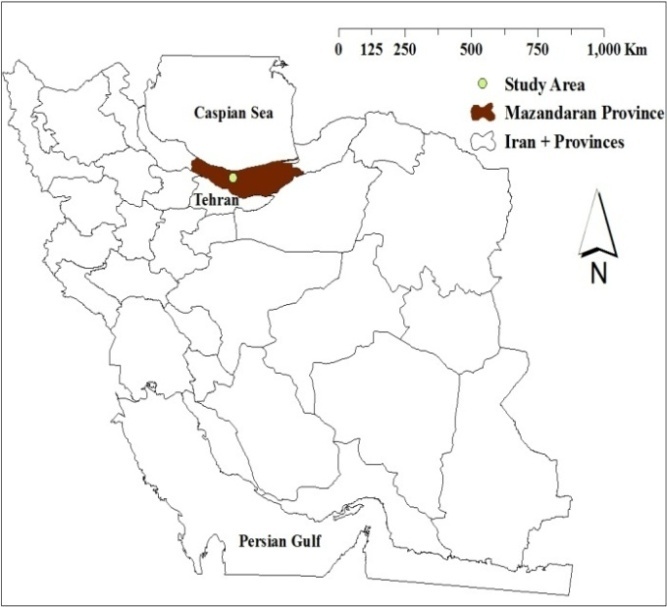


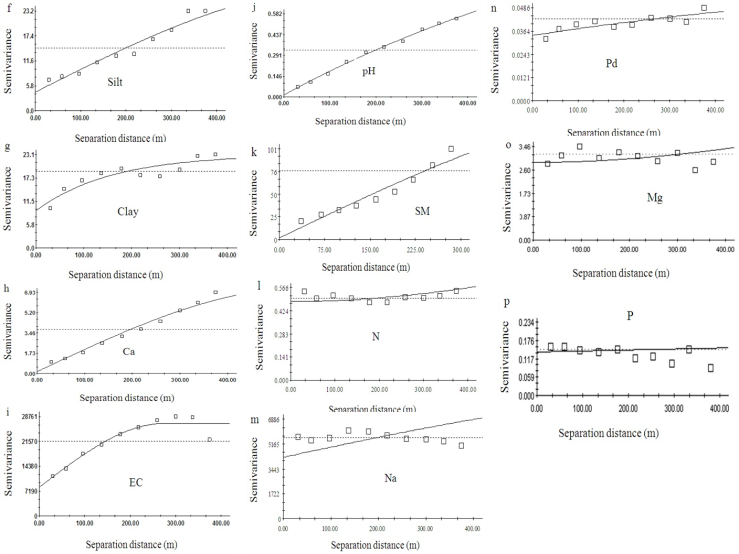
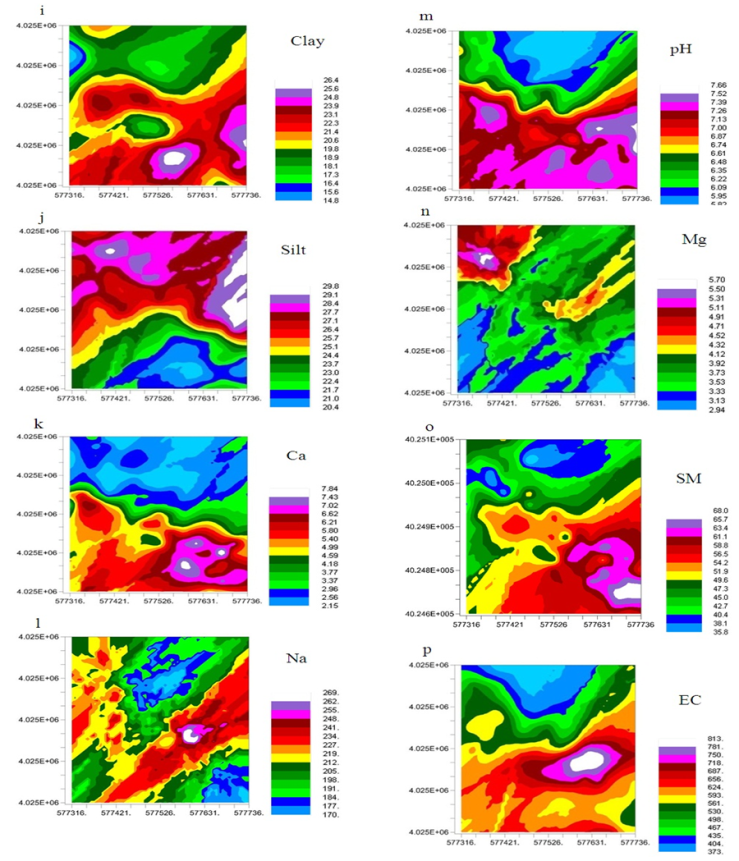
 Abstract
Abstract Reference
Reference Full-Text PDF
Full-Text PDF Full-text HTML
Full-text HTML